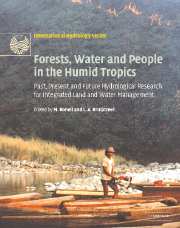 Forests, Water and People in the Humid Tropics
Forests, Water and People in the Humid Tropics Book contents
- Frontmatter
- Contents
- List of contributors
- Foreword
- Preface
- Acknowledgements
- Symposium and Workshop
- Introduction
- Part I Current trends and perspectives on people–land use–water issues
- Part II Hydrological processes in undisturbed forests
- Part III Forest disturbance, conversion and recovery
- Part IV New methods for evaluating effects of land-use change
- Part V Critical appraisals of best management practices
- Conclusion: Forests, water and people in the humid tropics: an emerging view
- Plate section
Part II - Hydrological processes in undisturbed forests
Published online by Cambridge University Press: 12 January 2010
- Frontmatter
- Contents
- List of contributors
- Foreword
- Preface
- Acknowledgements
- Symposium and Workshop
- Introduction
- Part I Current trends and perspectives on people–land use–water issues
- Part II Hydrological processes in undisturbed forests
- Part III Forest disturbance, conversion and recovery
- Part IV New methods for evaluating effects of land-use change
- Part V Critical appraisals of best management practices
- Conclusion: Forests, water and people in the humid tropics: an emerging view
- Plate section
Summary
SUMMARY
Callaghan and Bonell introduce the main features of the tropical atmospheric circulation as a step towards linking different synoptic-scale, rain-producing phenomena, their associated rainfall characteristics and the subsequent impacts on runoff hydrology.
Within the monsoon regions, three systems of convergence are identified, the northern monsoon shearline, the southern monsoon shearline and the maximum cloud zone associated with the monsoon westerlies in the vicinity of the equator. The most active monsoon shearline (otherwise known as the monsoon trough) is identified with the summer hemisphere. It is along this system that tropical cyclones often develop in response to convergent, opposing equatorial westerlies and trade wind easterlies, coupled with sea surface temperatures in excess of 26 οC. Low latitude tropical cyclones can, however, occur more rarely within 5ο of the equator, despite the common belief that the Earth's deflection (Coriolis) force is too weak in this zone for these storms to form. An alternative explanation is the short duration of the year when the monsoon trough is resident near the equator so that the chances for tropical cyclones to form are much reduced. It is noted that the zone of deepest convection and persistent cloud is associated with the maximum cloud zone of the equatorial westerlies due to the convergence of inter-hemispheric airstreams. Activity waxes and wanes in this sector in response to the varying strengths of the inter-hemispheric trade wind systems and the eastward propagation of a Kelvin wave known as the Madden—Julian Oscillation.
- Type
- Chapter
- Information
- Forests, Water and People in the Humid TropicsPast, Present and Future Hydrological Research for Integrated Land and Water Management, pp. 151 - 157Publisher: Cambridge University PressPrint publication year: 2005


